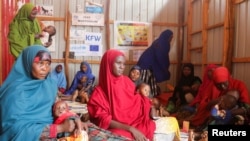Officials and aid workers in Somalia’s drought-stricken south say the area is expecting many deaths from famine if aid is not quickly scaled up.
Somalia’s South West state is one of the places the United Nations expects famine to arise as the prolonged and worst drought in 40 years continues to devastate the country.
State Humanitarian Affairs and Disaster Management Minister Nasir Arush told VOA in an interview after he visited hard-hit areas, including Wajid in Bakol region, that the situation there is desperate.
“You know, we have been dealing with drought for the last three years but the situation is getting really, really bad,” he said. “The latest report showed that 214,130 people in South West are in a catastrophic situation, that number was 112,400 on June 4.”
He said the urgent situation needs an urgent response.
Dr. Said Yusuf Mohamed who works at a stabilization center, a unit inside the biggest hospital in South West state, told VOA that the drought is having a devastating toll on children. He said that every day a child is dying at his stabilization center due to malnutrition.
He said you can see that the number of patients who need treatment for malnutrition is increasing and there are times when the hospital reaches beyond its capacity, and now it is possible to admit over 90 patients a week and sometimes more than 20 a day.
Maadeey Muumin is a 60-year-old a father of nine children. He arrived at the hospital with his malnourished granddaughter. He said he received an $8 loan from a family member to reach the hospital that is located over a hundred kilometers from their settlement.
He said people there are devastated by the drought that killed all their livestock and put the population at risk of starvation, especially their children.
Muumin said that the parents whose children are ill from malnutrition don’t have the resources to transport them to hospitals for treatment. He said if the drought continues until next year, the situation will only worsen. He said people there don’t have anywhere else to go.
On a trip for journalists to the famine-projected areas in South West arranged by the aid agency World Vision, Tobias Oloo, the World Vision operations manager told VOA that after four seasons of no rains, more than 7 million people are facing famine, in some places reaching starvation stage.
He said about 1 million people have been displaced and they are moving from locations where they cannot get help to locations where they can.
“Some areas have been affected more than others,” he said. We are seeing Baidoa is one of the areas that is seriously affected and also Burhakaba in Bay region of South West state. As an organization, we are providing cash so that people can buy food, we are providing assistance in water so that they can have water to drink; we are also providing protection programs to ensure that girls and women are protected from gender-based violence.”
Oloo said that the current drought is worse than the 2011 drought that killed thousands of Somalis because of a combination of Somalia’s internal conflicts, four consecutive rain failures and food prices skyrocketing due to Ukraine war.
Petroc Wilton, spokesman for the World Food Program in Somalia, told VOA that the WFP has been issuing warnings for months and is already actively assisting those in need.
“[The] WFP has been working to scale up humanitarian assistance to unprecedented levels in Somalia despite limited resources,” he said. “In July [the] WFP reached 3.7 million people in Somalia with lifesaving relief assistance, more than double the number in April, the most we ever reached in Somalia in a single month. We also reached over 300,000 with treatment of malnutrition.”
The Somali government last year declared the drought a national emergency and called for urgent help.
